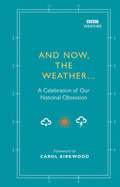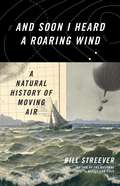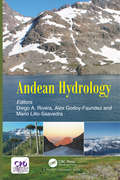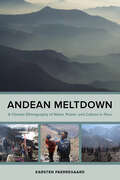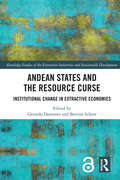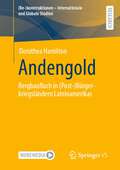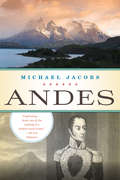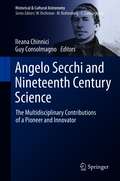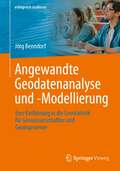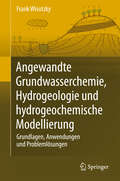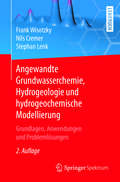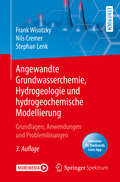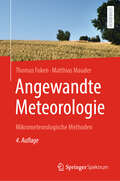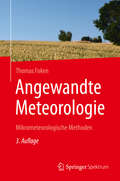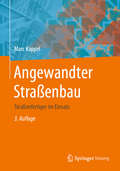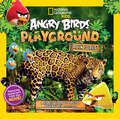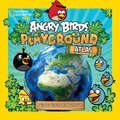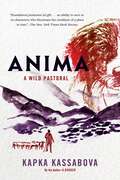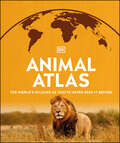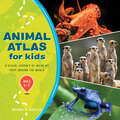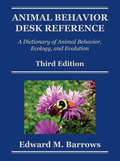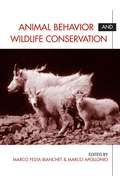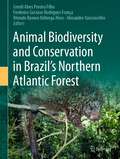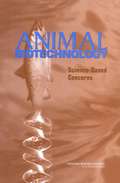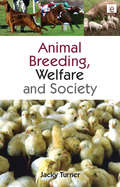- Table View
- List View
And Now, The Weather...: A celebration of our national obsession
by Alison MaloneyAlong with the fine art of queuing and proper tea, talking about the weather is the essence of Britishness. We’re all a little bit obsessed by it. Will it snow this Christmas? Was this year really the warmest on record? And where on earth did ‘raining cats and dogs’ come from? According to recent research, 94% of British people admit to having discussed the weather in the past six hours, while 38% say they have in the past 60 minutes. And Now, The Weather... is an almanac, a miscellany, and a celebration of our most famous obsession. Including beautiful illustrations, maps and line drawings, And Now, The Weather... is a perfect gift for the cloudspotter in your life.Features include:- The Lore of Weather – myths, legends and old wives tales about the weather.- Lost in Translation – Colloquial names for weather around the country, from Custard Winds to Mizzle. - Extreme Weather – Bizarre events in the history of British Weather including red rain and a downpour of frogs and fish.- Plus tables showing record breaking sunshine, wind speed, rainfall, heat etc.
And Soon I Heard a Roaring Wind: A Natural History of Moving Air
by Bill StreeverA thrilling exploration of the science and history of wind from the bestselling author of Cold.Scientist and bestselling nature writer Bill Streever goes to any extreme to explore wind--the winds that built empires, the storms that wreck them--by traveling right through it. Narrating from a fifty-year-old sailboat, Streever leads readers through the world's first forecasts, Chaos Theory, and a future affected by climate change. Along the way, he shares stories of wind-riding spiders, wind-sculpted landscapes, wind-generated power, wind-tossed airplanes, and the uncomfortable interactions between wind and wars, drawing from natural science, history, business, travel, as well as from his own travels. AND SOON I HEARD A ROARING WIND is an effortless personal narrative featuring the keen observations, scientific rigor, and whimsy that readers love. You'll never see a breeze in the same light again.
Andean Hydrology
by Diego A. Rivera Alex Godoy-Faundez Mario Lillo SaavedraThis book describes the ecosystem of the Andean watersheds, covering the Californian valley, tropical Andes, and southern Andes. Case studies of the new methods and techniques used for hydrological research in the Andes are provided, and sustainability issues pertaining to Andean water resources are discussed in the context of climate change, social and economic issues, and public policy. Furthermore, the impact of economic development on the Andean ecosystem, specifically the effect on the water cycle and the water-energy-food nexus, are examined.
Andean Meltdown: A Climate Ethnography of Water, Power, and Culture in Peru
by Karsten PaerregaardAndean Meltdown examines how climate change and its consequences for Peru's glaciers are affecting the country's water supply and impacting Andean society and culture in unprecedented ways. Drawing on forty years of extensive research, relationship building, and community engagement in Peru, Karsten Paerregaard provides an ethnographic exploration of Andean ritual practices and performances in the context of an altered climate. By documenting Andean peoples' responses to rapid glacier retreat and urgent water shortages, Paerregaard considers the myriad ways climate change intersects with environmental, social, and political change. A pathbreaking contribution to cultural anthropology and environmental humanities, Andean Meltdown challenges prevailing theoretical thinking about the culture-nature nexus and offers a new perspective on Andean peoples' understanding of their role as agents in the shifting relationship between humans and nonhumans.
Andean States and the Resource Curse: Institutional Change in Extractive Economies (Routledge Studies of the Extractive Industries and Sustainable Development)
by Gerardo Damonte Bettina SchorrThis volume explores institutional change and performance in the resource-rich Andean countries during the last resource boom and in the early post-boom years. The latest global commodity boom has profoundly marked the face of the resource-rich Andean region, significantly contributing to economic growth and notable reductions of poverty and income inequality. The boom also constituted a period of important institutional change, with these new institutions sharing the potential of preventing or mitigating the maladies extractive economies tend to suffer from, generally denominated as the “resource curse”. This volume explores these institutional changes in the Andean region to identify the factors that have shaped their emergence and to assess their performance. The interdisciplinary and comparative perspective of the chapters in this book provide fine-grained analyses of different new institutions introduced in the Andean countries and discusses their findings in the light of the resource curse approach. They argue that institutional change and performance depend upon a much larger set of factors than those generally identified by the resource curse literature. Different, domestic and external, economic, political and cultural factors such as ideological positions of decision-makers, international pressure or informal practices have shaped institutional dynamics in the region. Altogether, these findings emphasize the importance of nuanced and contextualized analysis to better understand institutional dynamics in the context of extractive economies. This book will be of great interest to students and scholars of the extractive industries, natural resource management, political economics, Latin American studies and sustainable development.
Andengold: Bergbaufluch in (Post-)Bürgerkriegsländern Lateinamerikas ((Re-)konstruktionen - Internationale und Globale Studien)
by Dorothea HamiltonDer 2016 unterschriebene Friedensvertrag mit FARC in Kolumbien stellt das Land u.a. vor die Frage, welche Bedeutung der Ressourcenreichtum des Landes für den Aufbau einer friedlichen Gesellschaft spielen soll. Abgeleitet von den Erkenntnissen aus Peru wird untersucht, welchen Einfluss der legale und nicht legale Abbau von Gold auf die jeweiligen bewaffneten Konflikte hatte, wie sich deren Nutzung in der Friedenszeit wandelte und welche neuen Konflikte entstanden sind. Zum Umgang mit der ehemaligen Konfliktressource Gold gibt es divergierende Vorstellungen, die extraktivistischen und postextraktivstischen Ideen zugeordnet werden können, die in lokalen Konflikten enden. Der Fokus liegt auf der subnationalen, nach Abbauart differenzierten Untersuchung von Ressourcenausbeutung und Bürgerkrieg bzw. Postbürgerkrieg. Die Ergebnisse zu illegalem Bergbau zeigen, dass es sich dabei nicht um ein Bürgerkriegsphänomen handelt, sondern vielmehr um eine geduldete Praxis, die die Bewaffnung von Gewaltakteuren bedingt. Aber auch legale Ressourcenförderung, die nach Beendigung des Konflikts als Strategie der Friedensfinanzierung verstanden wird, führt zu ähnlichen negativen Auswirkungen, sodass von einem Bergbaufluch gesprochen wird.
Andes: On My Grandfather's Trail In Chile And Bolivia
by Michael JacobsFor centuries, the Andes have caught the imagination of travelers, inspiring fear and wonder. The groundbreaking scientist Alexander von Humboldt claimed that "everything here is grander and more majestic than in the Swiss Alps, the Pyrenees, the Carpathians, the Apennines, and all other mountains I have known." Rivaled in height only by the Himalayas and stretching more than 4,500 miles, the sheer immensity of the Andes is matched by its concentration of radically contrasting scenery and climates, and the rich and diverse cultures of the people who live there. In this remarkable book, travel writer Michael Jacobs journeys across seven different countries, from the balmy Caribbean to the inhospitable islands of the Tierra del Fuego, through the relics of ancient civilizations and the remnants of colonial rule, retracing the footsteps of previous travelers. His route begins in Venezuela, following the path of the great nineteenth-century revolutionary Simón Bolívar, but soon diverges to include accounts from sources as varied as Humboldt, the young Charles Darwin, and Bolívar's extraordinary and courageous mistress, Manuela Saenz. On his way, Jacobs uncovers the stories of those who have shared his fascination and discovers the secrets of a region steeped in history, science, and myth.
Angelo Secchi and Nineteenth Century Science: The Multidisciplinary Contributions of a Pioneer and Innovator (Historical & Cultural Astronomy)
by Guy Consolmagno Ileana ChinniciAngelo Secchi was a key figure in 19th century science. An Italian Jesuit and scientist, he helped lead the transition from astronomy to astrophysics and left a lasting legacy in the field. Secchi’s spectral classification of stars was a milestone that paved the way for modern astronomical research. He was also a founder of modern meteorology and an innovator in the design and development of new instruments and methods across disciplines.This contributed volume collects together reviews from an international group of historians, scientists and scholars representing the multiple disciplines where Secchi made significant contributions during his remarkable career. It analyzes both his famous and lesser known pioneering efforts with equal vigor, providing a well-rounded narrative of his life’s work. Beyond his scientific and technological work, his role as a Jesuit priest in Rome during the turbulent years of the mid 19th century is also described and placed in the context of his scientific and civic activities.
Angewandte Geodatenanalyse und -Modellierung: Eine Einführung in die Geostatistik für Geowissenschaftler und Geoingenieure (erfolgreich studieren)
by Jörg BenndorfDie Fähigkeit, räumlich verteilte Daten zu analysieren und die darunterliegenden Prozesse und Strukturen zu verstehen und zu modellieren, ist in vielen Anwendungen der Geowissenschaften und des Geoingenieurwesens maßgebende Grundlage für weiterführende Arbeiten in der Erkenntnisgewinnung oder Planung/Projektierung. Das Fachgebiet der Geostatistik stellt dazu einen umfangreichen Pool an Methoden zur Verfügung, der sich fortwährend erweitert. Das vorliegende Buch ermöglicht sowohl dem Studierenden als auch dem Praktiker einen intuitiven Einstieg in die Grundlagen, Methoden und Anwendungen der Geostatistik. Dabei liegt der Fokus auf einer kurzen und prägnanten Darstellung von Schlüsselkonzepten, der kritischen Diskussion von Annahmen und Limitationen sowie der Illustration von Anwendungen anhand ausgewählter praktischer Beispiele. Übungsaufgaben bieten die Möglichkeit zur Vertiefung des Verständnisses sowie zur Selbstüberprüfung. An entsprechenden Textstellen sind Hinweise zu weiterführender Literatur gegeben. Nach erfolgreichem Studium des Buches gelingt es dem Leser, sich selbstständig in fortgeschrittene Aspekte der angewandten Geostatistik einzuarbeiten.
Angewandte Grundwasserchemie, Hydrogeologie und hydrogeochemische Modellierung: Grundlagen, Anwendungen und Problemlösungen
by Frank WisotzkyNeben den Anwendungen der Grundlagen der anorganischen Wasserchemie wird in dem Band erstmalig zusammenhängend die organische Wasserchemie von Grundwasserbelastungsstoffen behandelt. Darüber hinaus enthält er eine Einführung in die hydrochemische Modellierung und auch die chemischen Aspekte der Wasseraufbereitung werden dargestellt. Viele Beispiele aus der Praxis, Abbildungen und Schemazeichnungen machen die Grundwasserchemie nachvollziehbar und transparent. Mit zahlreichen Übungsaufgaben und dazugehörigen Lösungen.
Angewandte Grundwasserchemie, Hydrogeologie und hydrogeochemische Modellierung: Grundlagen, Anwendungen und Problemlösungen
by Frank Wisotzky Nils Cremer Stephan LenkNeben den Anwendungen der Grundlagen der anorganischen Wasserchemie wird in dem Band erstmalig zusammenhängend die organische Wasserchemie von Grundwasserbelastungsstoffen behandelt. Darüber hinaus enthält er eine Einführung in die hydrochemische Modellierung und auch die chemischen Aspekte der Wasseraufbereitung werden dargestellt. Viele Beispiele aus der Praxis, Abbildungen und Schemazeichnungen machen die Grundwasserchemie nachvollziehbar und transparent. Mit zahlreichen Übungsaufgaben und dazugehörigen Lösungen.
Angewandte Grundwasserchemie, Hydrogeologie und hydrogeochemische Modellierung: Grundlagen, Anwendungen und Problemlösungen
by Frank Wisotzky Nils Cremer Stephan LenkNeben den Anwendungen der Grundlagen der anorganischen Wasserchemie wird in dem Band erstmalig zusammenhängend die organische Wasserchemie von Grundwasserbelastungsstoffen behandelt. Darüber hinaus enthält er eine Einführung in die hydrochemische Modellierung und auch die chemischen Aspekte der Wasseraufbereitung werden dargestellt. Viele Beispiele aus der Praxis, Abbildungen und Schemazeichnungen machen die Grundwasserchemie nachvollziehbar und transparent. Mit zahlreichen Übungsaufgaben und dazugehörigen Lösungen.
Angewandte Meteorologie: Mikrometeorologische Methoden
by Thomas Foken Matthias MauderGegenstand des Buches sind die atmosphärischen Vorgänge im unmittelbaren Lebensraum des Menschen, also in den unteren 100 –1000 Metern der Atmosphäre und in Gebieten mit nur einigen Kilometern Ausdehnung. Dieser mikrometeorologische Raum wird in Büchern der allgemeinen Meteorologie nur wenig berücksichtigt. Damit bietet das Buch Grundlagen insbesondere für angewandte meteorologische Fachgebiete wie Biometeorologie, Agrarmeteorologie, Hydrometeorologie, Umweltmeteorologie und technische Meteorologie sowie für die Biogeochemie. Ein wichtiger Schwerpunkt sind dabei die Transportprozesse und Stoffflüsse zwischen Atmosphäre und Erdoberfläche, wobei bewachsene und heterogene Unterlagen eine besondere Beachtung finden.Die Autoren behandeln die Teilgebiete Theorie, Messtechnik, experimentelle Verfahren und Modellierung so, dass sie jeweils auch eigenständig für Lehre, Forschung und Praxis genutzt werden können.Neuerungen gegenüber der dritten Auflage sind Aktualisierungen und kleinere Ergänzungen in allen Kapiteln sowie ausgewählte inhaltliche Erweiterungen unter Berücksichtigung der Fragen des Klimawandels.
Angewandte Meteorologie: Mikrometeorologische Methoden
by Thomas FokenGegenstand des Buchs sind die atmosphärischen Vorgänge im Lebensraum des Menschen. Damit liefert es die Grundlagen insbesondere für die Biometeorologie, Agrarmeteorologie, Hydrometeorologie, Umweltmeteorologie und technische Meteorologie sowie für die Biogeochemie. Der Autor behandelt Theorie, Messtechnik, experimentelle Verfahren und Modellierung so, dass die Themen jeweils für sich stehen und die Inhalte einzeln in Lehre, Forschung und Praxis genutzt werden können. Für die Neuauflage wurden das Literaturverzeichnis und einzelne Kapitel erweitert.
Angewandter Straßenbau: Straßenfertiger im Einsatz
by Marc KappelAnschaulich werden die verschiedenen Verfahrens- und Arbeitstechniken im Straßenbau erklärt. Der Schwerpunkt liegt dabei auf dem Einsatz von Straßenfertigern im Oberbau. Es wird systematisch beschrieben, worauf es bei der Planung und Durchführung eines Straßenbauprojektes ankommt. An elf Beispielbaustellen wird mit handfesten Hinweisen und praktischen Tipps erklärt, wie der Oberbau einer Straße erstellt wird. Es werden zudem die theoretischen Grundlagen vermittelt sowie neueste Erkenntnisse der Forschung und Entwicklung vorgestellt. Dabei stehen vor allem die zunehmende Digitalisierung im Straßenbau, der Einfluss von Industrie 4.0 und BIM im Vordergrund.
Angry Birds Playground: A Forest Floor to Treetop Adventure
by Jill EsbaumFollow along with your favorite Angry Birds characters as they go on an incredible adventure through the rain forest. Kids will be hooked on a wacky mission to learn all about the rain forest so they can protect it from those bad piggies. Readers analyze and explore the most diverse ecosystem in the world as they build basic skills. Packed with learning exercises and fun activities, Angry Birds Playground: Rain Forest will transform kids into adventurers and leave them wanting more. It's a fun-tastic way to learn about a habitat in danger and the tens of thousands of creatures that call it home!
Angry Birds Playground: A Global Geography Adventure
by Elizabeth CarneyFollow along with your favorite Angry Birds characters as they fly around the world discovering continents, countries, and cultures. Kids will be hooked on a wacky search for the Angry Birds' eggs as they seek out clues that lead them to amazing discoveries. Readers analyze and observe the world from a global perspective as they build basic skills. Packed with learning exercises and fun activities, the Angry Birds Playground: Atlas will transform kids into explorers and leave them wanting more adventure.
Anima: A Wild Pastoral
by Kapka KassabovaIn Anima, Kapka Kassabova introduces us to the “pastiri” people—the shepherds struggling to hold on to an ancient way of life in which humans and animals exist in profound interdependence. Following her three previous books set in the Balkans, and with an increasinging interest in the degraded state of our planet and culture, Kassabova reaches further into the spirit of place than she ever has before. In this extraordinary portrayal of pastoral life, she investigates the heroic efforts to sustain the oldest surviving breeds of our domesticated animals, and she shows us the epic, orchestrated activity of transhumance—the seasonal movement, on foot, of a vast herd of sheep, working in tandem with dogs. She also becomes more and more attuned to the isolation and sacrifices inherent in the lives shaped by this work.Weaving together lyrical writing about place with a sweeping sense of the traumatic histories that have shaped this mountainous region of Bulgaria, Kassabova shows how environmental change and industrial capitalism are endangering older, sustainable ways of living, and by extension she reveals the limited nature of so much of modern life. But shining through Kassabova’s passionate, intimate response to the monoculture that is “Anthropos” is her indelible portrait of a circulating interdependence of people and animals that might point to a healthier way to live.
Animal Atlas (DK Where on Earth? Atlases)
by DKThis stunning new atlas is your first-class pass on a world tour of the homes of Earth's most incredible animals. The latest exciting title in DK's popular Where on Earth? series maps out the habitats of the world's mammals, fish, birds, reptiles, invertebrates, and more. Whether it's plotting the range of a lion, following the flight paths of birds, tracking great white sharks in the oceans, or exploring the migration of the monarch butterfly, you will see exactly where and how more than 100 extraordinary animal species live. What makes Animal Atlas unique are the maps themselves. Each one is individually commissioned in 3-D, with detail to show the habitat of each animal, as well as its geographic location. This reveals an astonishing amount of information about the behavior of these animals, from how seals are adapted to survive in freezing Antarctic seas to how beetles survive in the heat of the Sahara desert. There is also a focus on the conservation and protection of animals. Maps reveal the shrinking territories of some species, showing where they used to roam in the past compared to what's left of their range today. Whichever animal you're trying to track down, you're sure to find it in Animal Atlas.
Animal Atlas for Kids: A Visual Journey of Wildlife from Around the World
by Michael A. DiSpezioDiscover animals on every continent in a worldwide tour for kids ages 6 to 9 Spark children's curiosity and imagination with a whole world of amazing animals! This animal atlas introduces kids to more than 180 animals from all over the globe. They'll explore colorful maps of every continent and ocean and learn all about the creatures that live there. From the smallest insects to the biggest whales, kids can meet each one up close with photos and find out fun facts about their natural environment. Kids will discover animals like: CHIMPANZEE, African Rainforests—Chimpanzees live in trees and grasslands. Like other apes, they are highly intelligent. They also laugh when they're playing! TARANTULA, Central America—Tarantulas are large spiders. They have eight legs like other spiders, but they do not spin webs. Instead, they live in an underground burrow. SIBERIAN CHIPMUNK, Northern Asia—Like all chipmunks, a Siberian chipmunk has stripes along its back. It also has cheek pouches that carry food—kind of like grocery bags! BELUGA WHALE, Arctic Ocean—This white whale produces all sorts of sounds and has a thick layer of fat under its skin, called blubber. Encourage kids' passion for the natural world with this entertaining choice in educational animal books for kids.
Animal Behavior Desk Reference: A Dictionary of Animal Behavior, Ecology, and Evolution, Third Edition
by Edward M. Barrows"Words are our tools, and, as a minimum, we should use clean tools. We should know what we mean and what we do not, and we must forearm ourselves against the traps that language sets us." -- The Need for Precise Terminology, Austin (1957, 7-8) It follows that, for effective and efficient communication, people should have, or at least understand, th
Animal Behavior and Wildlife Conservation
by Marco Apollonio Marco Festa-BianchetEfforts to conserve wildlife populations and preserve biological diversity are often hampered by an inadequate understanding of animal behavior. How do animals react to gaps in forested lands, or to sport hunters? Do individual differences--in age, sex, size, past experience--affect how an animal reacts to a given situation? Differences in individual behavior may determine the success or failure of a conservation initiative, yet they are rarely considered when strategies and policies are developed. Animal Behavior and Wildlife Conservation explores how knowledge of animal behavior may help increase the effectiveness of conservation programs. The book brings together conservation biologists, wildlife managers, and academics from around the world to examine the importance of general principles, the role played by specific characteristics of different species, and the importance of considering the behavior of individuals and the strategies they adopt to maximize fitness.Each chapter begins by looking at the theoretical foundations of a topic, and follows with an exploration of its practical implications. A concluding chapter considers possible future contributions of research in animal behavior to wildlife conservation.
Animal Biodiversity and Conservation in Brazil's Northern Atlantic Forest
by Rômulo Romeu Nóbrega Alves Gentil Alves Pereira Filho Frederico Gustavo Rodrigues França Alexandre VasconcellosThis book describes the fauna of the Pernambuco Endemism Center in Brazil's Northern Atlantic Forest, an understudied global biodiversity hotspot. Through fifteen curated chapters, it provides the latest information about the fauna of the northern portion of the Atlantic Forest, gathering important information about the faunal composition of the region for the first time. The chapters address animal biodiversity including terrestrial and aquatic vertebrates (fish, amphibians, reptiles, birds, and mammals) and invertebrates (ants, butterflies, dung beetles, hervestmen, spiders, and termites). All chapters provide species lists, taxonomic aspects and richness analysis. Conservation of specific animal groups is also discussed. Finally, the book discusses human impacts on the forest and its biodiversity, emphasizing the need for conservation of this highly impacted ecosystem.
Animal Biotechnology: Science-based Concerns
by National Research CouncilGenetic-based animal biotechnology has produced new food and pharmaceutical products and promises many more advances to benefit humankind. These exciting prospects are accompanied by considerable unease, however, about matters such as safety and ethics. This book identifies science-based and policy-related concerns about animal biotechnology—key issues that must be resolved before the new breakthroughs can reach their potential.The book includes a short history of the field and provides understandable definitions of terms like cloning. Looking at technologies on the near horizon, the authors discuss what we know and what we fear about their effects—the inadvertent release of dangerous microorganisms, the safety of products derived from biotechnology, the impact of genetically engineered animals on their environment. In addition to these concerns, the book explores animal welfare concerns, and our societal and institutional capacity to manage and regulate the technology and its products. This accessible volume will be important to everyone interested in the implications of the use of animal biotechnology.
Animal Breeding, Welfare and Society
by Jacky TurnerThe determination of when, how, how often and with whom an animal breeds is moving rapidly away from evolutionary pressures and towards human purposes: these include the breeding of around 50 billion mammals and birds for food production annually, the breeding of pedigree dogs and cats, racing dogs and horses, specialised laboratory animal strains and the use of reproductive science to conserve endangered species or breeds and to limit unwanted populations of pests and non-native species. But the ethics and sustainability of this takeover of animals' reproductive lives have been insufficiently examined by either professionals or the public. This book discusses the methods, the motivations and the consequences of human intervention in animal breeding in terms of animal health, behaviour and well-being. It explores where we are now and the choices ahead, and looks to a future where we have more respect for animals as sentient beings and where we could loosen the reins of reproductive control.
